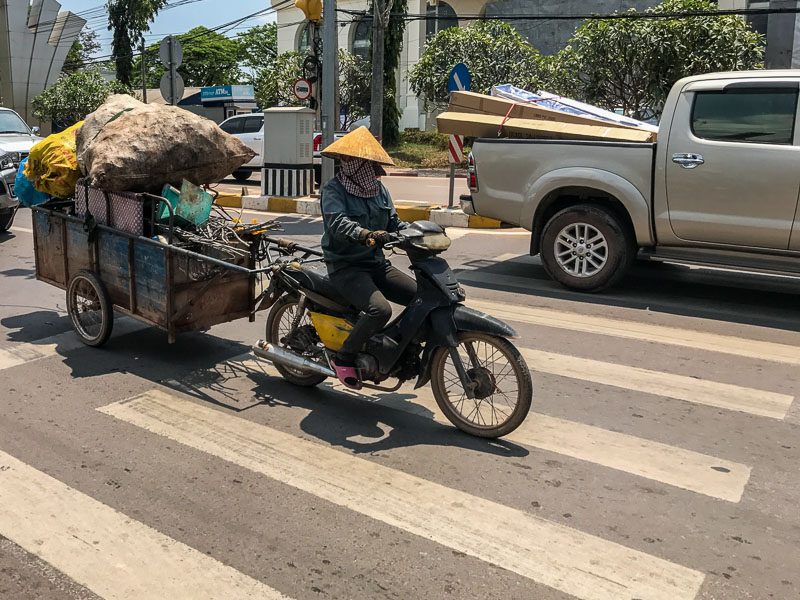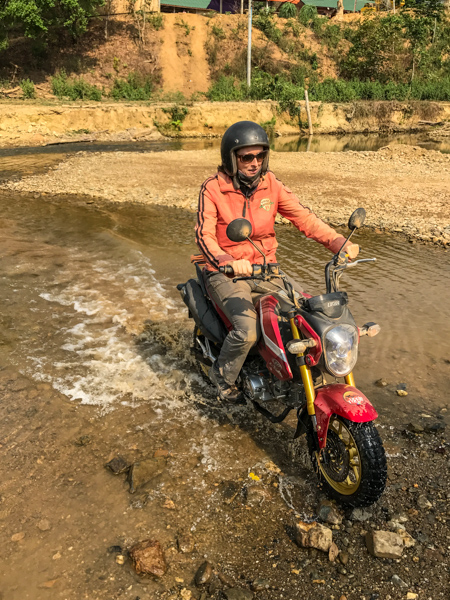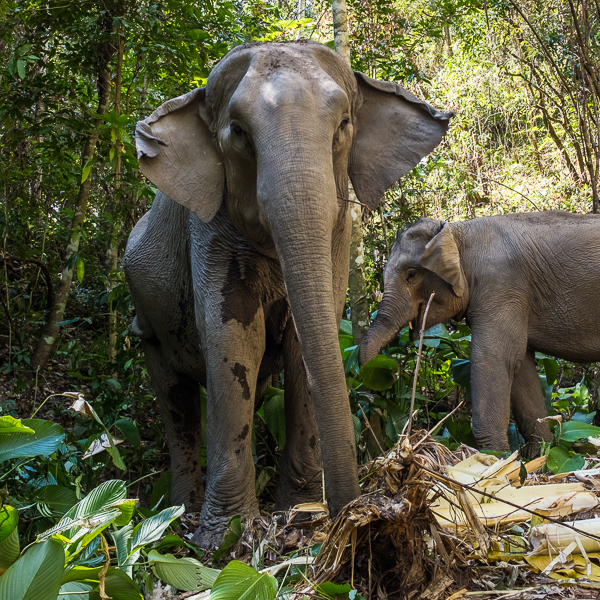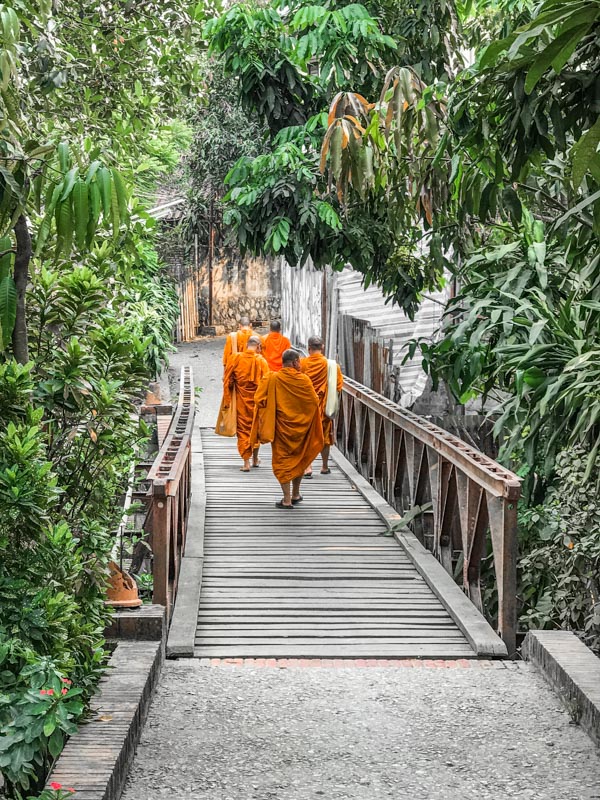Discovering Laos: Things to Do in Vientiane
Covered in dust and with grins a mile wide we said farewell to Tom at the Kasi International Bus Station (more of a barren piece of land). Our luxury coach south from Kasi was another open-sided truck, this time complete with a one-eyed driver. We bounced our way through the vibrant, lush countryside, surrounded at times by towering karst formations.
One night in Vang Vieng
We spent just 18 hours in Vang Vieng which used to be known as the hell hole of South East Asia. Backpackers descended on this town back in the late 90’s. Back then a litre of rice whisky was cheaper than water. Bars sprung up on a daily basis along a one kilometre stretch of the river. Add in a fast following river and you have a recipe for disaster. Tubing and Ziplining quickly became the in thing. There was hardly a week went by without some young traveller scoring a first class ticket home in a lie flat coffin. Today it is a little calmer, but still full of young backpackers hugging tightly to a tube of rubber.
Keen to leave Vang Vieng at the earliest opportunity, at the bus station we were very impressed with the VIP bus that would whisk us to Vientiane. Trouble was that one wasn't our bus. Ours was a tired old trooper that coughed and wheezed its way to the capital.
Giving Vientiane Some Love
Like Luang Prabang, the Mekong River snakes its way alongside Vientiane, separating Laos from Thailand. Close to three-quarters of a million people live here making it Laos largest city.
Julie managed to score a cracker of a hotel for the price of a hostel. The Xaysomboun Boutique Hotel was a lot more luxury that we had been used to, there was even a pool. A perfect place to unwind for a while after the dust and grime of the previous few days.
The capital doesn’t get much love as a travellers destination. But there are enough things to do in Vientiane to keep you occupied for several days if you are prepared to put the effort in.
We were a short walk from the historic centre and the river. The park that runs alongside the river comes alive at night with a huge local market (mostly clothes and phone cases), several outdoor fitness classes, add in a thick aroma of Asian food and you have a heady cocktail of nightlife. Several of the roads leading to the park are lined with restaurants and bars, our favourtie was Tyson’s.
The Patuxai Arch or Victory Gate is a central monument that was built to celebrate those that suffered in the struggle for independence from France. Ironically it is known as the Laos version of the Arch de Triumph, only this one is not quite finished. A sign on the arch reads “From a closer distance, it is even less impressive, like a monster of concrete”. If the arch had feelings I’m sure they would be bruised at such a brutal statement.
Do you think it's ugly?
We wandered around the Pha That Luang Temple, the national symbol of Laos. Believed to have initially been a Hindu temple in the 3rd century, this is now the most important moment in Laos. Of course the Golden Stupa was undergoing restoration, the scaffold tour continues. Across the way, is the Vat That Khao with its stunning reclining gold Budda. The gardens and various buildings that make up this complex can quickly soak away an hour or two.
The scaffold tour continues at Pha That Lung Temple
Glistening Golden Reclining Buddha
COPE Centre, a reality check
We stupidly decided to walk to our next destination which was much further than we thought. The baking sun didn't help with the navigation and harmony between the two of us.
It turns out Laos holds the dubious record of being the most bombed country in the world, relative to the size of the population. During the Vietnam War, the US dropped some two million tonnes of bombs on Laos to cut off the supply routes for the North Vietnamese Army. That equates to a plane load of bombs every 8 minutes, 24 hours a day for 9 years. Some 80 million bombs failed to explode, rendering much of the countryside off limits. The unexploded cluster bombs have killed or maimed at least 50,000 people since the end of the war, many of these children.
Cluster bomb display at the COPE centre
The COPE Centre is a non-profit organization that works in conjunction with the Laos Ministry of Health to provide support to those impacted by unexploded bombs. It is a rehabilitation centre with a focus on providing access to orthotic/prosthetic devices and services. The visitor centre provides a short and sobering insight into how the mass bombings still affect everyday life especially outside of the major centres. In a nearby sports hall, a game of wheelchair basketball was taking place.
much better than many able bodied players
There is no charge to visit the centre, but I challenge anybody to walk away without leaving a donation. In fact, we counted our blessings that we could walk away.
Street Life, Vientiane Style
Heading back to the hotel one evening, we stopped at a 7-Eleven to grab some water when we heard an awful crash. A scooter rider had t-boned a minibus. He hit the bus so hard that the windows popped out on the side of the impact. Julie quickly untangled the rider from the bike and tried to make him as comfortable as possible. In the meantime I had to get in the face of an elderly American tourist has she tried to take photos of the poor guy laying mangled on the road. An ambulance eventually turned up and we left the scene, hopefully, the young man made a full recovery.
Walking can prove to a bit of challenge in Vientiane. The locals see the pavement as ideal parking zones for scooters and cars alike. Walking does, however, throw up some interesting sites on the road as old meets new.
We wrapped up our time with visits to two nearby temples, Haw Phra Kaew and Wat Si Saket, the later is much more traditional. The central Buddha at Saket is surrounded by covered walkways containing hundreds of Buddha statues, many in need of some drastic plastic surgery.
That was Laos. A fascinating two-week insight into a South East Asia’s only landlocked country. The highlight for both of us was the time spent motorbiking with Uncle Tom’s Trails. A mixture of being outside our comfort zone, seeing rural Laos life and hanging with the cheeky Welshman. The countryside is varied and beautiful, the people so welcoming and the food is up there with the best that South East Asia has to offer. There are some sights like the Plain of Jars that we wished we had visited, any excuse to return at some stage.
Check Out - Hints & Info
- We stayed at: The Xaysomboun Boutique Hotel in Vientiane, cost per night NZ$33.25 (US$24/£19) included ensuite, breakfast and pool.
- We stayed at: Pam's Hostel in Vang Vieng, cost per night NZ$11.50 (US$8/£6) included nothing, not even air con. Very basic but fine for one night
- We ate at: Tyson, Namaste Indian, Lao Kitchen, all very tasty and good value for money.
- Bus from Luang Prabang to Kasi was NZ$14 (US$10/£8) each
- Bus from Kasi to Vang Vieng was NZ$5.25 (US$3.80/£3) each
- Bus from Vang Vieng to Vientiane was NZ$7 (US$5/£4) each




















